Today, cities are where most people live, and that’s going to be even more true in the future according to the United Nations. As more people move to cities, making cities good places to live becomes even more important for people and the planet. How can we teach urban designers to do this?
Urban designers are the ones who make cities work well. They need to create safe places for people to live, find jobs, and feel good. Plus, cities need to handle tough stuff like climate change and big problems like pandemics. Here at Häme University of Applied Sciences (HAMK), we’ve been working on a study plan for a degree in Sustainable Urban Design to teach the future urban designers about making cities sustainable. We have checked out different programs around the world and added our own cool ideas that could change how we teach future urban designers.
To make cities better for the future, we’ve got to think a lot more about nature and how cities affect it. To do this, it’s really important to move away from the old way of teaching city planning and design from the US that mostly cared about where cars could go and not so much about people. We need to focus more on ways for folks to get around sustainably, like using public transportation and walking. This is something many programs in East Asia and Scandinavia are already doing.
Also, instead of just talking about rules for cities, we need to teach things like how people work together and how history shapes cities. This helps designers understand the different groups of people and their different needs in cities.
So, what makes a good study plan for making cities better?
First, it’s about looking at cities as a whole package. We will be teaching designers to see that cities are more than just buildings—they’re made up of things like roads, rails, pipes for water, energy, and of course green spaces like parks or tree-lined streets. That means the study plan will cover lots of different parts of city design and how they connect to each other.
Second, students will learn about how things get built. This will help them understand how cities are made from the ground up, not just looking at the design but the materials used and the upkeep needed to keep cities working.
Third, students will learn about using data and tech in city planning, just like they do in programs in Australia. This means teaching students how to use info to make good choices about building and keeping up cities. It also means letting folks who live in cities help out by sharing what they see and know about their neighborhoods, like if there are problems with traffic lights or the air quality.
Our new degree for city design mixes ideas with practical stuff and gets students ready to work in teams on real situations and in different places. By paying attention to new ideas about making things better and helping students learn about them, our new degree will help make the next group of city designers able to make cities that work for everyone.
Authors
Philip Vaughter, Senior Lecturer, Sustainable Urban Design
Sonja Heikkinen, Head of Degree Programme, Traffic and Transport Management




